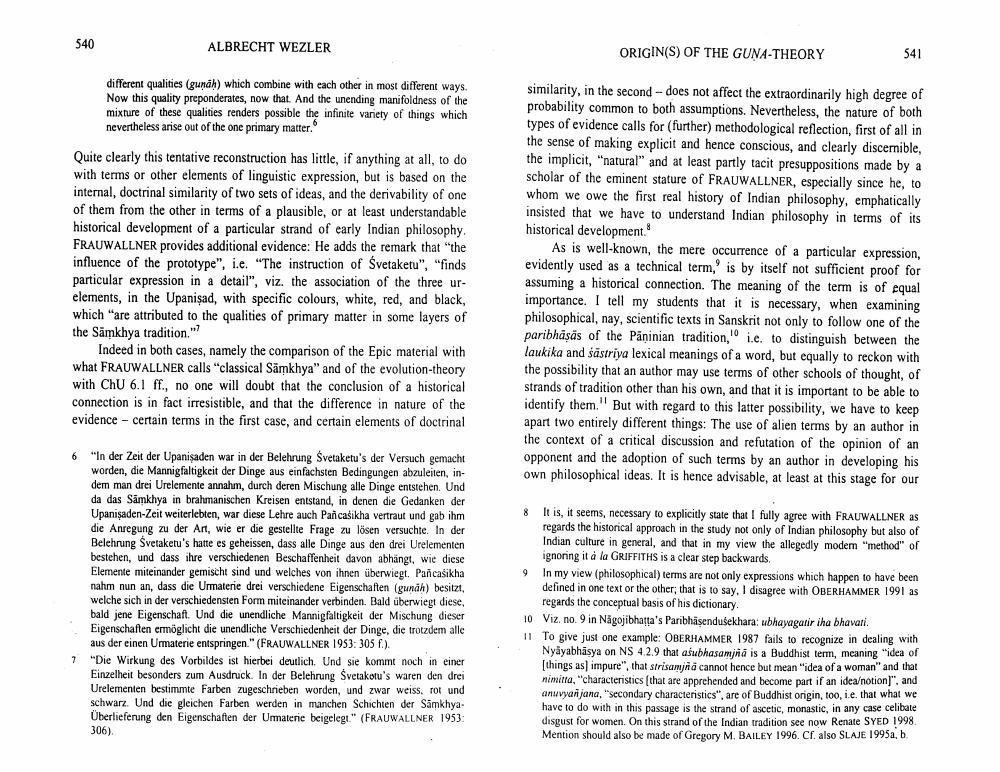________________
540
ALBRECHT WEZLER
different qualities (gunah) which combine with each other in most different ways. Now this quality preponderates, now that. And the unending manifoldness of the mixture of these qualities renders possible the infinite variety of things which nevertheless arise out of the one primary matter.
Quite clearly this tentative reconstruction has little, if anything at all, to do with terms or other elements of linguistic expression, but is based on the internal, doctrinal similarity of two sets of ideas, and the derivability of one of them from the other in terms of a plausible, or at least understandable historical development of a particular strand of early Indian philosophy. FRAUWALLNER provides additional evidence: He adds the remark that "the influence of the prototype", i.e. "The instruction of Svetaketu", "finds particular expression in a detail", viz. the association of the three urelements, in the Upanisad, with specific colours, white, red, and black, which "are attributed to the qualities of primary matter in some layers of the Samkhya tradition.""
Indeed in both cases, namely the comparison of the Epic material with what FRAUWALLNER calls "classical Samkhya" and of the evolution-theory with ChU 6.1 ff., no one will doubt that the conclusion of a historical connection is in fact irresistible, and that the difference in nature of the evidence certain terms in the first case, and certain elements of doctrinal
6 "In der Zeit der Upanisaden war in der Belehrung Svetaketu's der Versuch gemacht worden, die Mannigfaltigkeit der Dinge aus einfachsten Bedingungen abzuleiten, indem man drei Urelemente annahm, durch deren Mischung alle Dinge entstehen. Und da das Samkhya in brahmanischen Kreisen entstand, in denen die Gedanken der Upanisaden-Zeit weiterlebten, war diese Lehre auch Pañcasikha vertraut und gab ihm die Anregung zu der Art, wie er die gestellte Frage zu lösen versuchte. In der Belehrung Svetaketu's hatte es geheissen, dass alle Dinge aus den drei Urelementen bestehen, und dass ihre verschiedenen Beschaffenheit davon abhängt, wie diese Elemente miteinander gemischt sind und welches von ihnen überwiegt. Pañcasikha nahm nun an, dass die Urmaterie drei verschiedene Eigenschaften (gunah) besitzt, welche sich in der verschiedensten Form miteinander verbinden. Bald überwiegt diese, bald jene Eigenschaft. Und die unendliche Mannigfaltigkeit der Mischung dieser Eigenschaften ermöglicht die unendliche Verschiedenheit der Dinge, die trotzdem alle aus der einen Urmaterie entspringen." (FRAUWALLNER 1953: 305 f.).
7 "Die Wirkung des Vorbildes ist hierbei deutlich. Und sie kommt noch in einer Einzelheit besonders zum Ausdruck. In der Belehrung Svetakotu's waren den drei Urelementen bestimmte Farben zugeschrieben worden, und zwar weiss, rot und schwarz. Und die gleichen Farben werden in manchen Schichten der Sämkhya. Überlieferung den Eigenschaften der Ummaterie beigelegt." (FRAUWALLNER 1953: 306).
ORIGIN(S) OF THE GUNA-THEORY
similarity, in the second - does not affect the extraordinarily high degree of probability common to both assumptions. Nevertheless, the nature of both types of evidence calls for (further) methodological reflection, first of all in the sense of making explicit and hence conscious, and clearly discernible, the implicit, "natural" and at least partly tacit presuppositions made by a scholar of the eminent stature of FRAUWALLNER, especially since he, to whom we owe the first real history of Indian philosophy, emphatically insisted that we have to understand Indian philosophy in terms of its historical development.
8
541
As is well-known, the mere occurrence of a particular expression, evidently used as a technical term," is by itself not sufficient proof for assuming a historical connection. The meaning of the term is of equal importance. I tell my students that it is necessary, when examining philosophical, nay, scientific texts in Sanskrit not only to follow one of the paribhāṣäs of the Päninian tradition, i.e. to distinguish between the laukika and sastriya lexical meanings of a word, but equally to reckon with the possibility that an author may use terms of other schools of thought, of strands of tradition other than his own, and that it is important to be able to identify them." But with regard to this latter possibility, we have to keep apart two entirely different things: The use of alien terms by an author in the context of a critical discussion and refutation of the opinion of an opponent and the adoption of such terms by an author in developing his own philosophical ideas. It is hence advisable, at least at this stage for our
8 It is, it seems, necessary to explicitly state that I fully agree with FRAUWALLNER as regards the historical approach in the study not only of Indian philosophy but also of Indian culture in general, and that in my view the allegedly modern "method" of ignoring it à la GRIFFITHS is a clear step backwards.
9
In my view (philosophical) terms are not only expressions which happen to have been defined in one text or the other; that is to say, I disagree with OBERHAMMER 1991 as regards the conceptual basis of his dictionary.
10 Viz. no. 9 in Nägojibhatta's Paribhäṣendusekhara: ubhayagatir iha bhavati.
11 To give just one example: OBERHAMMER 1987 fails to recognize in dealing with Nyayabhasya on NS 4.2.9 that asubhasamjñā is a Buddhist term, meaning "idea of [things as] impure", that strisanjña cannot hence but mean "idea of a woman" and that nimitta, "characteristics (that are apprehended and become part if an idea/notion]", and anuvyanjana, "secondary characteristics", are of Buddhist origin, too, i.e. that what we have to do with in this passage is the strand of ascetic, monastic, in any case celibate disgust for women. On this strand of the Indian tradition see now Renate SYED 1998. Mention should also be made of Gregory M. BAILEY 1996. Cf. also SLAJE 1995a, b.




